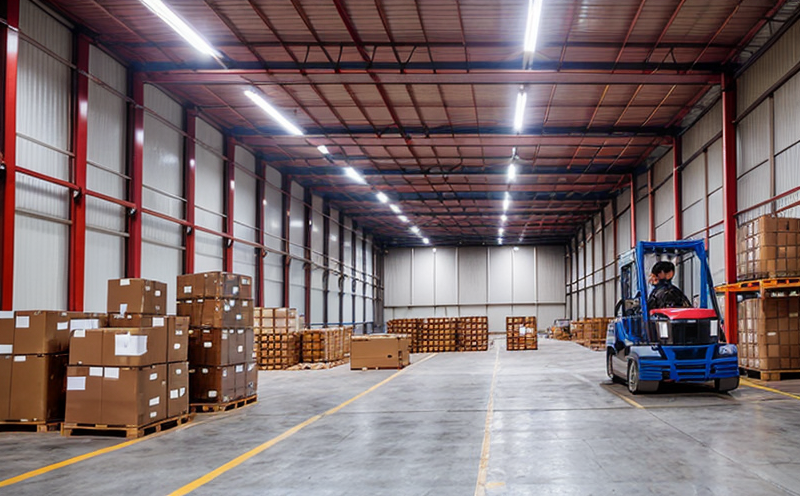ASTM D999 Vibration Testing of Packaged Products
The ASTM D999 vibration testing method is a critical procedure in ensuring that packaged products are robust and reliable under dynamic environmental conditions. This test evaluates the impact of mechanical vibrations on packaging design, materials, and product integrity during transportation or handling processes. Quality managers and compliance officers rely on such tests to ensure that their products meet the necessary standards for safety and performance.
Vibration testing is particularly important in industrial manufacturing where packaging plays a crucial role in protecting goods from damage. This test simulates real-world conditions by subjecting packaged products to controlled vibration levels, frequencies, and durations. The purpose of this testing is to identify any potential weaknesses or failures that could lead to product damage before they reach the end user.
The ASTM D999 standard specifies the method for determining the effect of mechanical vibrations on packages containing liquids by subjecting them to a specified frequency range (typically between 10 and 40 Hz) with varying amplitudes. This testing is essential because it helps manufacturers understand how their packaging will perform under various transportation scenarios, such as shipping via truck or airplane.
Before conducting ASTM D999 tests, it’s important to prepare the specimens correctly. Samples should be representative of the actual package design and must not have any pre-existing defects that could affect test results. Additionally, the test samples need to be filled with a specified liquid medium (usually water) up to a certain level to simulate typical shipping conditions.
The testing apparatus used in ASTM D999 includes a vibration table or shaker system capable of generating controlled frequencies and amplitudes within the specified ranges. The device must also provide accurate measurement capabilities for monitoring the applied forces during the test cycle. Once configured, the test begins by placing the specimen on the shaker platform while ensuring that it remains stable throughout the process.
After completing one full cycle of vibration exposure (typically 10 minutes), the sample is inspected for any signs of damage or leakage. Any issues found are recorded and documented along with detailed observations about the nature and extent of the damage observed. This information helps manufacturers refine their designs further to enhance resistance against future tests.
ASTM D999 testing plays a vital role in validating the effectiveness of protective packaging materials used during shipping and handling operations across various industries, including automotive, electronics, pharmaceuticals, and consumer goods sectors. By adhering to this standard, companies can demonstrate compliance with relevant regulations while also improving overall product quality.
Understanding the implications of ASTM D999 is crucial for those involved in industrial manufacturing processes where packaging integrity is paramount. Compliance officers responsible for ensuring adherence to international standards will find value in learning more about how these tests contribute towards meeting global requirements related to product safety and durability.
Applied Standards
| Standard Number | Title of Standard | Description |
|---|---|---|
| ASTM D999-18a | Vibration Testing of Packaged Products Containing Liquids | This standard specifies the procedure for determining the effect of mechanical vibrations on packages containing liquids by subjecting them to controlled frequency and amplitude ranges. |
| ISO 2637-1:2004 | Vibration—Basic Transmissibility Characteristics and Models | This international standard provides guidance on basic transmissibility characteristics which can be used alongside ASTM D999 for more comprehensive vibration analysis. |
| Standard Number | Title of Standard | Description |
|---|---|---|
| ASTM E494-18 | Vibration Testing of Packaged Products Containing Solids | This standard covers the procedure for determining the effect of mechanical vibrations on packages containing solids, which can complement ASTM D999 when dealing with different types of packaged goods. |
| ISO 2637-2:2018 | Vibration—Vibration Transmissibility Characteristics and Models for Non-Sinusoidal Excitation | This additional ISO standard offers insights into vibration transmissibility characteristics under non-sinusoidal excitations, providing broader applicability beyond just ASTM D999. |
Why Choose This Test
Vibration testing according to ASTM D999 is an indispensable tool for industrial manufacturers looking to enhance the quality and reliability of their packaged products. By subjecting packages containing liquids to controlled vibration conditions, this test helps uncover potential weaknesses in packaging design or material selection that may not be apparent through static testing alone.
One key advantage of ASTM D999 is its ability to simulate realistic transportation scenarios such as truck rides, plane flights, and other forms of logistics. This allows manufacturers to anticipate the stresses their products might encounter during shipment and adjust accordingly. Additionally, compliance with this standard demonstrates commitment to meeting international regulatory requirements related to product safety.
The test also serves educational purposes by providing valuable feedback on package performance. Manufacturers can use the insights gained from ASTM D999 testing to improve future iterations of packaging designs, leading to enhanced durability and reduced risk of damage during transit.
Another benefit is improved supply chain efficiency. By identifying problematic areas early in the development process, companies can avoid costly recalls or returns later down the line, thereby streamlining operations and reducing costs associated with product failures.
Environmental and Sustainability Contributions
- Promotes sustainable practices by helping manufacturers design more resilient packaging that reduces waste from damaged goods during transit.
- Encourages recycling efforts through better package durability, minimizing the need for frequent replacements due to damage.
- Aids in reducing carbon footprints associated with product transportation by ensuring packages are robust enough to minimize returns or replacements caused by improper handling.





